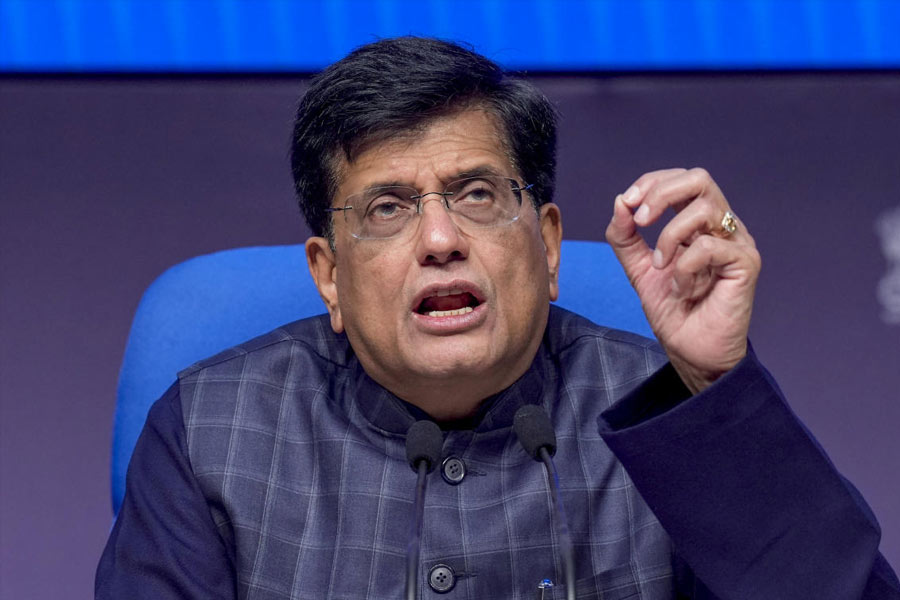 |
| Indian street art is the inspiration behind Prachi Grover’s miniature pottery range; Pic by Jagan Negi |
Studio potter Rashi Jain is surrounded on all sides by her creations. There are salad platters and muesli bowls lining several shelves and quirky sculptural pieces made from stoneware and terracotta in another corner of her studio. On any given day she might start out by making strictly functional pieces like ceramic tableware and then move on to make decorative figurines and even wall hangings.
Bangalore-based studio potter Sumanth Sampath prefers to focus almost entirely on functional pieces. His speciality is turning out items like jugs, pitchers, platters and bowls in stoneware and porcelain and he’s currently turning out high-end tableware for six different fine dining restaurants in Bangalore. All around in his studio there are items like milk pitchers, ice-tea pitchers and what he calls biryani bowls. There are even pots which he says resemble Tajine pots (used for North African cuisine) and sashimi plates and beer mugs. “My restaurant lines have tableware suitable for various cuisines,” he says.
Jain and Sampath are studio potters and they walk a fine line between art and functionality — one day you might find them turning out highly artistic sculptural products and on another they’ll be making highly functional items like plates, mugs and pitchers. Studio potters give their work a degree of exclusivity by turning out small batches of individual products or even making unique ones.
Says celebrated potter Anjani Khanna: “Studio-pottery may not have any utility value but can be purely aesthetic. Since it’s not something that’s mass-produced, it has a premium attached to it.”
 |
| stoneware and terracotta are what Shalan Dere works with in her studio.(Below) Rashi Jain is gearing up for a solo sculptural show at the Jehangir Art Gallery in Mumbai in August; |
 |
 |
 |
Delhi-based potter-entrepreneur Ruchira Bhatia aims to spread the word about studio pottery and to that end she set up an online pottery boutique, Saundhi Mitti, earlier this year. Using the web she hopes to retail studio pottery from all over the country. “I wanted to create a viable platform for studio-potters wherever they are,” says Bhatia, who quit a job in marketing and went on to learn studio pottery. Today, she works at the Sanskriti Kala Kendra set up by Delhi Blue, a pioneering organisation that was originally set up to revive old forms like Mughal glaze pottery.
What has led to the growth of studio-pottery in India? As the spending power of the Indian middle class increases, studio potters are finding buyers for their wares. And the rise of lifestyle stores provide a readymade platform for studio potters to sell their stuff.
There are even studio pottery markets that have sprung up in various Indian cities. Anjani Khanna, for instance, has joined hands with Rashi Jain to set up what are called potters’ markets in India. One of the biggest of these makes its appearance at Mumbai’s Kala Ghoda Festival. Says Khanna: “When we started out at the Kala Ghoda Festival in Mumbai we reckoned we would get about 13 or 14 potters. Today, we’ve got 40 potters and similar markets are coming up in Bangalore, Bhopal, Delhi and Calcutta.”
Studio potters are creating all manner of attractive objects. Take, for instance, Delhi based Prachi Grover, 32, who’s working on a miniature range of pottery inspired by Indian street art. “Like in the West where you can pick up miniature pieces as mementoes, I want to start a miniature series which will be smaller line of utility items like small tea-kettles, bells, key chains and so on,” says Grover.
Besides that Grover also makes a wide range of products — everything from small wall murals to coasters, napkin holders, vases, square-shaped platters and dip-platters for kababs. Grover too chucked up a job in the corporate world and took courses at Anandgram in Delhi. Making functional pottery in stoneware and terracotta is her forte.
Mumbai-based Shalan Dere took up the craft more as a hobby and was pushed into it by her daughter. For starters, she took a one-and-a-half month course at the JJ School of Arts in Mumbai in 1993. “It was not a planned journey but I got hooked on to it after that,” she says.
She now runs her own studio called Potter’s Place and mainly works with stoneware products that are created at very high temperatures. She also creates terracotta abstract art. Her signature pieces include ceramic figurines, handmade tiles, wall murals, colourful bowls and mugs, leaf-shaped plates, quirky jars and platters.
Some studio potters focus more on abstract sculptural pieces. One such is Delhi-based Rekha Bajpe Aggarwal, 43, whose forte is more to do with ‘modernist abstracts’. “I use clay more as a medium of expression rather than to make functional work,” she says. Aggarwal has showcased her works in several Delhi galleries. Besides abstracts, she does wheel-thrown functional work. Her signature pieces include baskets, fish shaped bowls and square big boxes in clay.
 |
 |
| (Top) A JJ School of Art graduate, Rekha Goyal is now working on decorative wall-pieces for a five-star hotel; (above) her interest in studio pottery made Ruchira Bhatia give up a marketing job and take to the art full time |
At a slightly different level, Mumbai-based studio potter Rekha Goyal, 32, works in her home studio converting ideas into fascinating shapes. Currently, she is working on decorative wall-pieces for a five-star hotel. She also dabbles in making all kinds of unusual but functional products in clay. For instance, she recently made quirky washbasins for an organic resort. Besides that she turns out everything from book-ends to personalised nameplates and handmade tiles to coffee mugs. Goyal graduated in Fine Art from the JJ School of Art, Mumbai, in 2002 and did an MA in Art in Architecture from the School of Architecture & Visual Arts, UK, in 2004.
Indian studio potters are doing their level best to stay on the cutting-edge and give a contemporary twist to their works. “They are keen to explore newer techniques, learn new concepts and give textures to their products,” says Sampath. So, you have Dere who is experimenting and trying out sawdust firing. For this she has to burnish the object (when the clay is semi-dry the potter polishes the surface of the object with the back of a spoon till it gets a glossy finish). She then puts it in a kiln and gives it a regular firing (called ‘bisque’ firing). The next step is what is called sawdust firing in which the pots are placed in a kiln made out of bricks and covered with sawdust. “The fumes from this give a combination of dark and light texture,” she says.
Others are experimenting with the ancient Japanese Raku firing technique. Here, the fired piece is removed from the hot kiln and put directly into water or allowed to cool in the open air. So, while Sampath does Raku firing for his tableware, Aggarwal does Naked Raku (this technique leaves a deliberate smoky effect on the body of the unglazed pot) to bring out a black and white effect.
Jain, on the other hand, specialises in Anagama firing for her jars in stoneware. The term (it’s Japanese for ‘cave kiln’) describes single chamber, wood-burning kilns in which temperatures can go up to 1,400°F). Wood ash settles on the pieces during the firing and the complex interaction between flame, ash and the minerals form a natural ash glaze on the surface of the pot.
 |
| (Left) Sumanth Sampath is working on a line of tableware for fine dining restaurants in Bangalore; (below) Rekha Bajpe Aggarwal’s forte is modernist abstracts in clay Pix by Jagan Negi. |
 |
Texturisation is another technique to create products with a difference. Here the potters create different textures on wet clay. So, Aggarwal creates unique textures with anything from wire mesh to stamps, wooden blocks, corrugated paper, keys, barks of trees and even stones on her line of platters, wall murals and handmade tiles.
And Grover has used lace to imprint patterns on a clay surface. Other textures include wall-paper cuttings and veins of leaves for some of her platters and also shells for chandeliers. “One has to get these impressions before the first bisque firing when the clay is still wet,” she says. Bhatia made a series of pendants in stoneware using wooden textile blocks to get the desired motifs.
There are other ways too to make their products stand out. Sampath has used figurative handles instead of regular handles in his line of Tajine bowls. And Grover has been inspired by Indian street art while designing her array of tea-kettles.
Of course, studio pottery has a premium tag attached to it. The potters make niche products in small batches. Prices can range from around Rs 100 for a small item to Rs 30,000 for some more complex ones. Says Jain: “Firstly, one has to understand that it is not just a clay mug which you are picking up but there is an aesthetic element into it. The fact that these are handmade as opposed to machine-produced makes it expensive. You have to pay for the exclusivity.”
Getting into the studio pottery game can still be expensive. It can cost nearly Rs 2 lakh just for the basics of a studio. A potter’s wheel, for instance, costs around Rs 30,000. Jain feels that studio pottery is “still seen as a craft form and is not treated at par with painting and photography.”
Says Sunaina Anand, director, Art Alive gallery, Delhi: “There are very few galleries to support this genre. Therefore, studio potters really need to stand out and make outstanding creations for galleries to be taken seriously at par with paintings.”
But the studio potters have bright hopes for the future. After all, the Indian middle class is getting more affluent and demanding beautiful products for their homes. And studio potters are at their wheels creating objects of beauty.










